MGMT20129 Module Assessment 2: Developing Management Capability Report
VerifiedAdded on 2020/04/07
|26
|3900
|201
Report
AI Summary
This report, prepared for the MGMT20129 module on Developing Management Capability, delves into the concepts of conflict and negotiation within organizational settings. It begins with a comprehensive literature review, examining definitions and theories of conflict, including the social conflict theory and negotiation strategies. The report then employs three diagnostic tools: the Thomas-Kilmann Conflict Style Questionnaire to assess assertiveness and cooperativeness, the Big Five Personality Test to evaluate personality traits, and the Johari Window Questionnaire to analyze self-awareness and feedback. The analysis of these tools reveals the author's tendencies in conflict situations, highlighting strengths and weaknesses. Based on the findings, a detailed development plan is proposed to address identified shortcomings, particularly emotional responses and a tendency to prioritize others' needs. The report concludes by summarizing the key insights and recommendations for personal and professional growth.
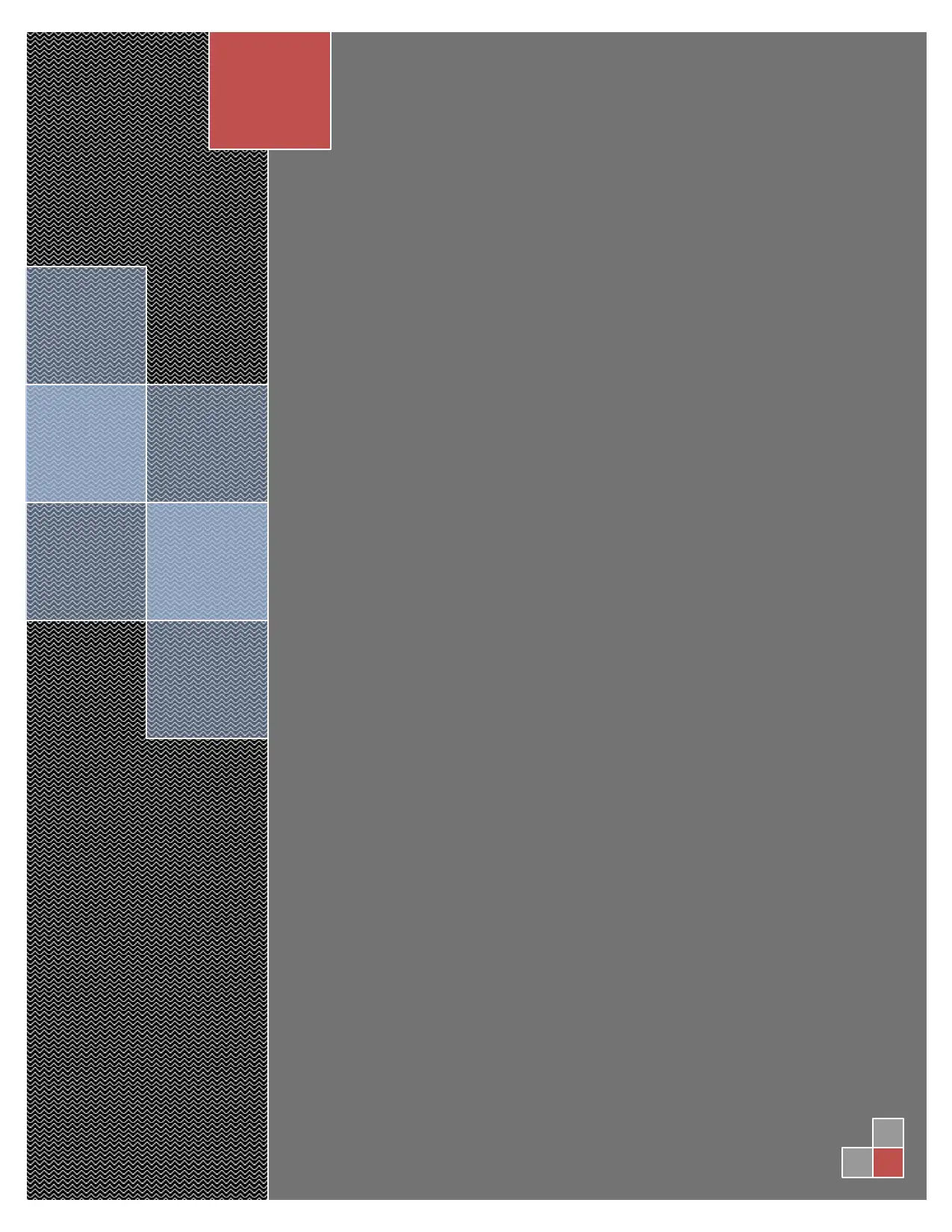
Paraphrase This Document
Need a fresh take? Get an instant paraphrase of this document with our AI Paraphraser
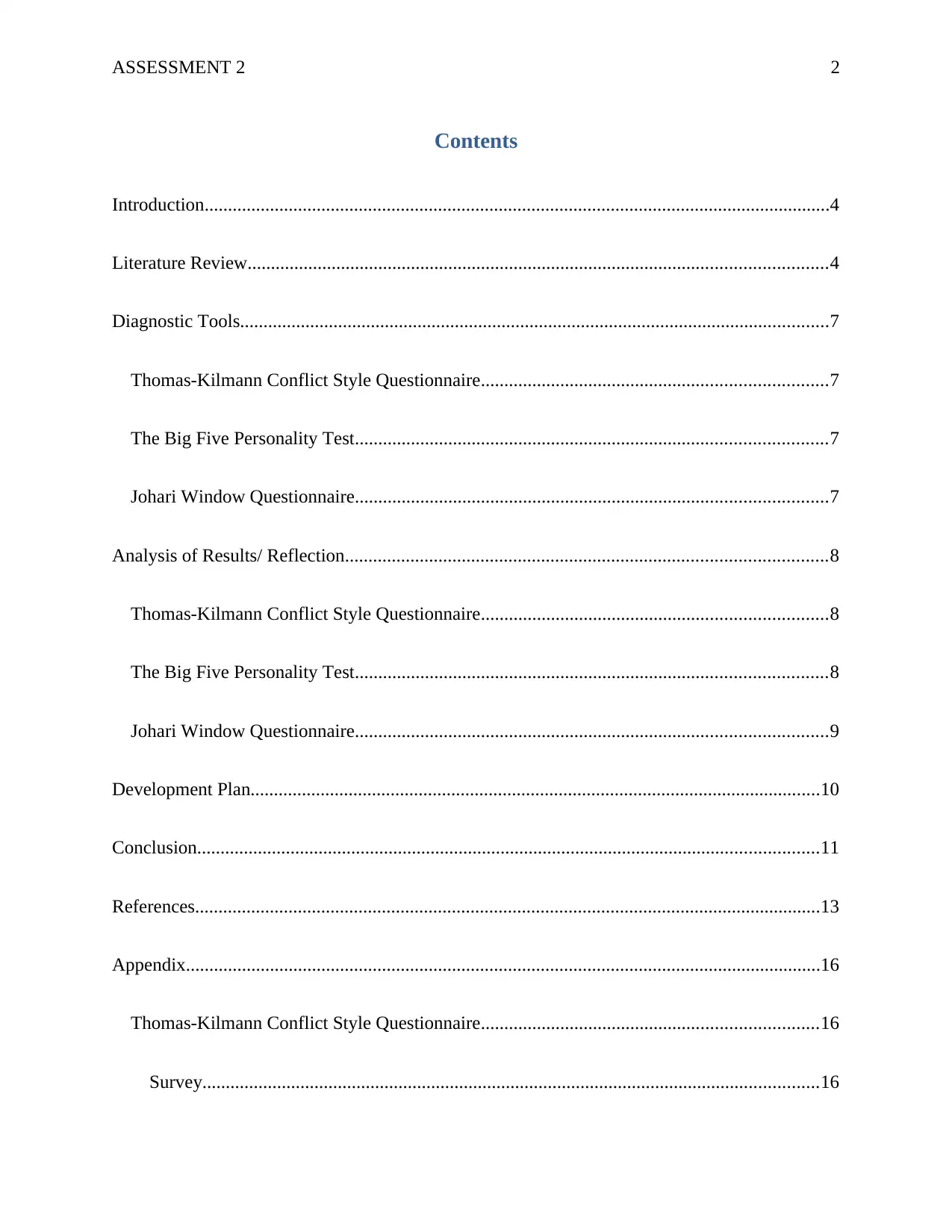
ASSESSMENT 2 2
Contents
Introduction......................................................................................................................................4
Literature Review............................................................................................................................4
Diagnostic Tools..............................................................................................................................7
Thomas-Kilmann Conflict Style Questionnaire..........................................................................7
The Big Five Personality Test.....................................................................................................7
Johari Window Questionnaire.....................................................................................................7
Analysis of Results/ Reflection.......................................................................................................8
Thomas-Kilmann Conflict Style Questionnaire..........................................................................8
The Big Five Personality Test.....................................................................................................8
Johari Window Questionnaire.....................................................................................................9
Development Plan..........................................................................................................................10
Conclusion.....................................................................................................................................11
References......................................................................................................................................13
Appendix........................................................................................................................................16
Thomas-Kilmann Conflict Style Questionnaire........................................................................16
Survey....................................................................................................................................16
Contents
Introduction......................................................................................................................................4
Literature Review............................................................................................................................4
Diagnostic Tools..............................................................................................................................7
Thomas-Kilmann Conflict Style Questionnaire..........................................................................7
The Big Five Personality Test.....................................................................................................7
Johari Window Questionnaire.....................................................................................................7
Analysis of Results/ Reflection.......................................................................................................8
Thomas-Kilmann Conflict Style Questionnaire..........................................................................8
The Big Five Personality Test.....................................................................................................8
Johari Window Questionnaire.....................................................................................................9
Development Plan..........................................................................................................................10
Conclusion.....................................................................................................................................11
References......................................................................................................................................13
Appendix........................................................................................................................................16
Thomas-Kilmann Conflict Style Questionnaire........................................................................16
Survey....................................................................................................................................16
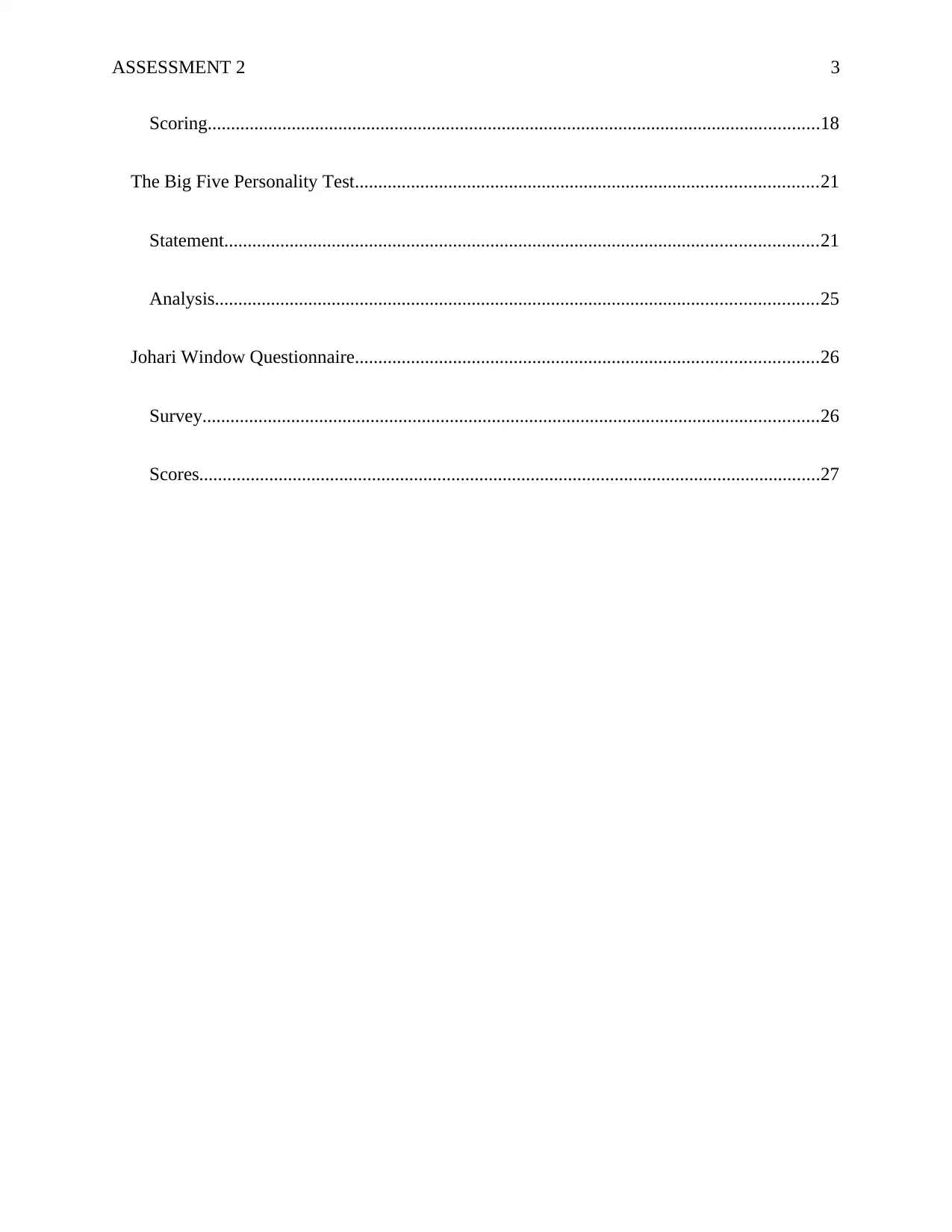
ASSESSMENT 2 3
Scoring...................................................................................................................................18
The Big Five Personality Test...................................................................................................21
Statement...............................................................................................................................21
Analysis.................................................................................................................................25
Johari Window Questionnaire...................................................................................................26
Survey....................................................................................................................................26
Scores.....................................................................................................................................27
Scoring...................................................................................................................................18
The Big Five Personality Test...................................................................................................21
Statement...............................................................................................................................21
Analysis.................................................................................................................................25
Johari Window Questionnaire...................................................................................................26
Survey....................................................................................................................................26
Scores.....................................................................................................................................27
⊘ This is a preview!⊘
Do you want full access?
Subscribe today to unlock all pages.

Trusted by 1+ million students worldwide
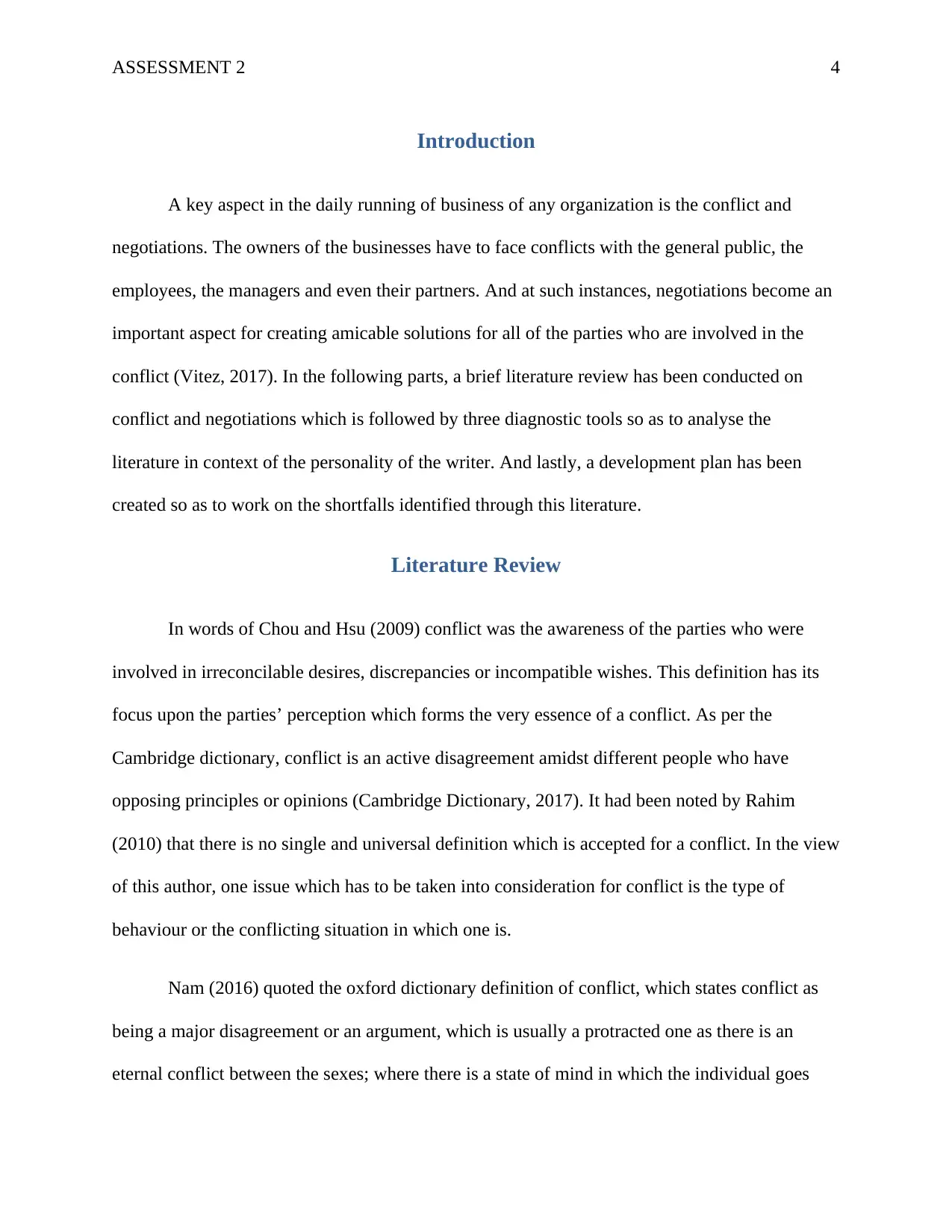
ASSESSMENT 2 4
Introduction
A key aspect in the daily running of business of any organization is the conflict and
negotiations. The owners of the businesses have to face conflicts with the general public, the
employees, the managers and even their partners. And at such instances, negotiations become an
important aspect for creating amicable solutions for all of the parties who are involved in the
conflict (Vitez, 2017). In the following parts, a brief literature review has been conducted on
conflict and negotiations which is followed by three diagnostic tools so as to analyse the
literature in context of the personality of the writer. And lastly, a development plan has been
created so as to work on the shortfalls identified through this literature.
Literature Review
In words of Chou and Hsu (2009) conflict was the awareness of the parties who were
involved in irreconcilable desires, discrepancies or incompatible wishes. This definition has its
focus upon the parties’ perception which forms the very essence of a conflict. As per the
Cambridge dictionary, conflict is an active disagreement amidst different people who have
opposing principles or opinions (Cambridge Dictionary, 2017). It had been noted by Rahim
(2010) that there is no single and universal definition which is accepted for a conflict. In the view
of this author, one issue which has to be taken into consideration for conflict is the type of
behaviour or the conflicting situation in which one is.
Nam (2016) quoted the oxford dictionary definition of conflict, which states conflict as
being a major disagreement or an argument, which is usually a protracted one as there is an
eternal conflict between the sexes; where there is a state of mind in which the individual goes
Introduction
A key aspect in the daily running of business of any organization is the conflict and
negotiations. The owners of the businesses have to face conflicts with the general public, the
employees, the managers and even their partners. And at such instances, negotiations become an
important aspect for creating amicable solutions for all of the parties who are involved in the
conflict (Vitez, 2017). In the following parts, a brief literature review has been conducted on
conflict and negotiations which is followed by three diagnostic tools so as to analyse the
literature in context of the personality of the writer. And lastly, a development plan has been
created so as to work on the shortfalls identified through this literature.
Literature Review
In words of Chou and Hsu (2009) conflict was the awareness of the parties who were
involved in irreconcilable desires, discrepancies or incompatible wishes. This definition has its
focus upon the parties’ perception which forms the very essence of a conflict. As per the
Cambridge dictionary, conflict is an active disagreement amidst different people who have
opposing principles or opinions (Cambridge Dictionary, 2017). It had been noted by Rahim
(2010) that there is no single and universal definition which is accepted for a conflict. In the view
of this author, one issue which has to be taken into consideration for conflict is the type of
behaviour or the conflicting situation in which one is.
Nam (2016) quoted the oxford dictionary definition of conflict, which states conflict as
being a major disagreement or an argument, which is usually a protracted one as there is an
eternal conflict between the sexes; where there is a state of mind in which the individual goes
Paraphrase This Document
Need a fresh take? Get an instant paraphrase of this document with our AI Paraphraser
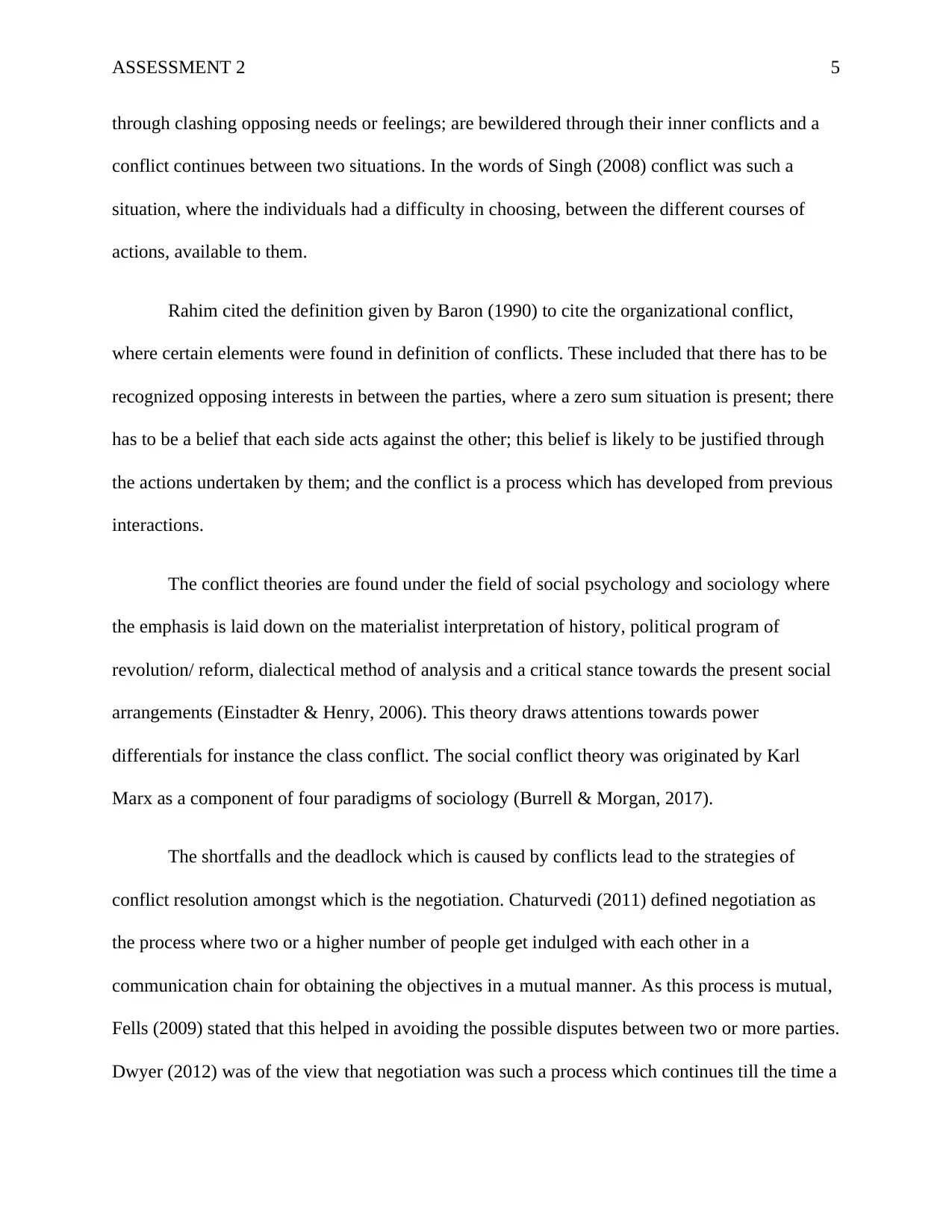
ASSESSMENT 2 5
through clashing opposing needs or feelings; are bewildered through their inner conflicts and a
conflict continues between two situations. In the words of Singh (2008) conflict was such a
situation, where the individuals had a difficulty in choosing, between the different courses of
actions, available to them.
Rahim cited the definition given by Baron (1990) to cite the organizational conflict,
where certain elements were found in definition of conflicts. These included that there has to be
recognized opposing interests in between the parties, where a zero sum situation is present; there
has to be a belief that each side acts against the other; this belief is likely to be justified through
the actions undertaken by them; and the conflict is a process which has developed from previous
interactions.
The conflict theories are found under the field of social psychology and sociology where
the emphasis is laid down on the materialist interpretation of history, political program of
revolution/ reform, dialectical method of analysis and a critical stance towards the present social
arrangements (Einstadter & Henry, 2006). This theory draws attentions towards power
differentials for instance the class conflict. The social conflict theory was originated by Karl
Marx as a component of four paradigms of sociology (Burrell & Morgan, 2017).
The shortfalls and the deadlock which is caused by conflicts lead to the strategies of
conflict resolution amongst which is the negotiation. Chaturvedi (2011) defined negotiation as
the process where two or a higher number of people get indulged with each other in a
communication chain for obtaining the objectives in a mutual manner. As this process is mutual,
Fells (2009) stated that this helped in avoiding the possible disputes between two or more parties.
Dwyer (2012) was of the view that negotiation was such a process which continues till the time a
through clashing opposing needs or feelings; are bewildered through their inner conflicts and a
conflict continues between two situations. In the words of Singh (2008) conflict was such a
situation, where the individuals had a difficulty in choosing, between the different courses of
actions, available to them.
Rahim cited the definition given by Baron (1990) to cite the organizational conflict,
where certain elements were found in definition of conflicts. These included that there has to be
recognized opposing interests in between the parties, where a zero sum situation is present; there
has to be a belief that each side acts against the other; this belief is likely to be justified through
the actions undertaken by them; and the conflict is a process which has developed from previous
interactions.
The conflict theories are found under the field of social psychology and sociology where
the emphasis is laid down on the materialist interpretation of history, political program of
revolution/ reform, dialectical method of analysis and a critical stance towards the present social
arrangements (Einstadter & Henry, 2006). This theory draws attentions towards power
differentials for instance the class conflict. The social conflict theory was originated by Karl
Marx as a component of four paradigms of sociology (Burrell & Morgan, 2017).
The shortfalls and the deadlock which is caused by conflicts lead to the strategies of
conflict resolution amongst which is the negotiation. Chaturvedi (2011) defined negotiation as
the process where two or a higher number of people get indulged with each other in a
communication chain for obtaining the objectives in a mutual manner. As this process is mutual,
Fells (2009) stated that this helped in avoiding the possible disputes between two or more parties.
Dwyer (2012) was of the view that negotiation was such a process which continues till the time a
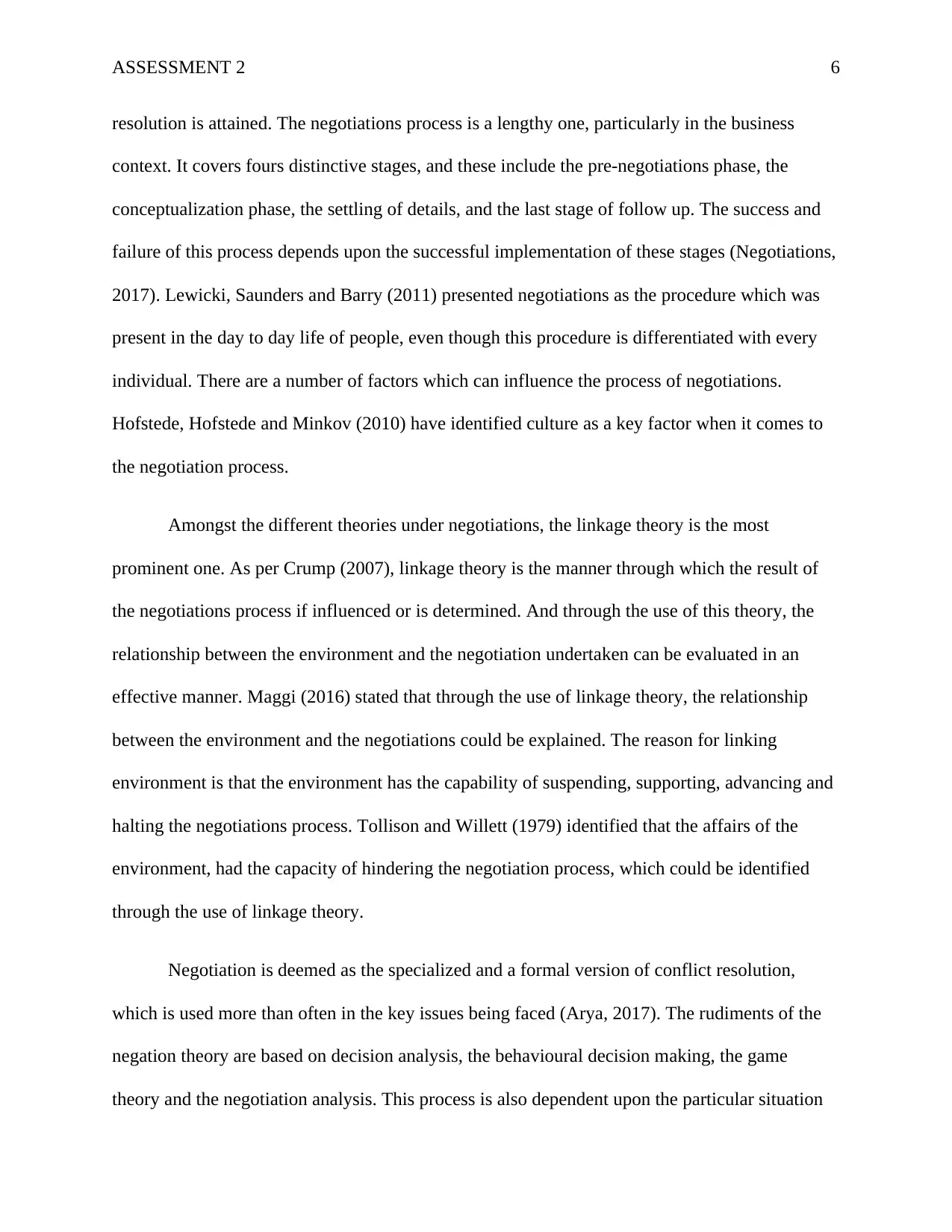
ASSESSMENT 2 6
resolution is attained. The negotiations process is a lengthy one, particularly in the business
context. It covers fours distinctive stages, and these include the pre-negotiations phase, the
conceptualization phase, the settling of details, and the last stage of follow up. The success and
failure of this process depends upon the successful implementation of these stages (Negotiations,
2017). Lewicki, Saunders and Barry (2011) presented negotiations as the procedure which was
present in the day to day life of people, even though this procedure is differentiated with every
individual. There are a number of factors which can influence the process of negotiations.
Hofstede, Hofstede and Minkov (2010) have identified culture as a key factor when it comes to
the negotiation process.
Amongst the different theories under negotiations, the linkage theory is the most
prominent one. As per Crump (2007), linkage theory is the manner through which the result of
the negotiations process if influenced or is determined. And through the use of this theory, the
relationship between the environment and the negotiation undertaken can be evaluated in an
effective manner. Maggi (2016) stated that through the use of linkage theory, the relationship
between the environment and the negotiations could be explained. The reason for linking
environment is that the environment has the capability of suspending, supporting, advancing and
halting the negotiations process. Tollison and Willett (1979) identified that the affairs of the
environment, had the capacity of hindering the negotiation process, which could be identified
through the use of linkage theory.
Negotiation is deemed as the specialized and a formal version of conflict resolution,
which is used more than often in the key issues being faced (Arya, 2017). The rudiments of the
negation theory are based on decision analysis, the behavioural decision making, the game
theory and the negotiation analysis. This process is also dependent upon the particular situation
resolution is attained. The negotiations process is a lengthy one, particularly in the business
context. It covers fours distinctive stages, and these include the pre-negotiations phase, the
conceptualization phase, the settling of details, and the last stage of follow up. The success and
failure of this process depends upon the successful implementation of these stages (Negotiations,
2017). Lewicki, Saunders and Barry (2011) presented negotiations as the procedure which was
present in the day to day life of people, even though this procedure is differentiated with every
individual. There are a number of factors which can influence the process of negotiations.
Hofstede, Hofstede and Minkov (2010) have identified culture as a key factor when it comes to
the negotiation process.
Amongst the different theories under negotiations, the linkage theory is the most
prominent one. As per Crump (2007), linkage theory is the manner through which the result of
the negotiations process if influenced or is determined. And through the use of this theory, the
relationship between the environment and the negotiation undertaken can be evaluated in an
effective manner. Maggi (2016) stated that through the use of linkage theory, the relationship
between the environment and the negotiations could be explained. The reason for linking
environment is that the environment has the capability of suspending, supporting, advancing and
halting the negotiations process. Tollison and Willett (1979) identified that the affairs of the
environment, had the capacity of hindering the negotiation process, which could be identified
through the use of linkage theory.
Negotiation is deemed as the specialized and a formal version of conflict resolution,
which is used more than often in the key issues being faced (Arya, 2017). The rudiments of the
negation theory are based on decision analysis, the behavioural decision making, the game
theory and the negotiation analysis. This process is also dependent upon the particular situation
⊘ This is a preview!⊘
Do you want full access?
Subscribe today to unlock all pages.

Trusted by 1+ million students worldwide
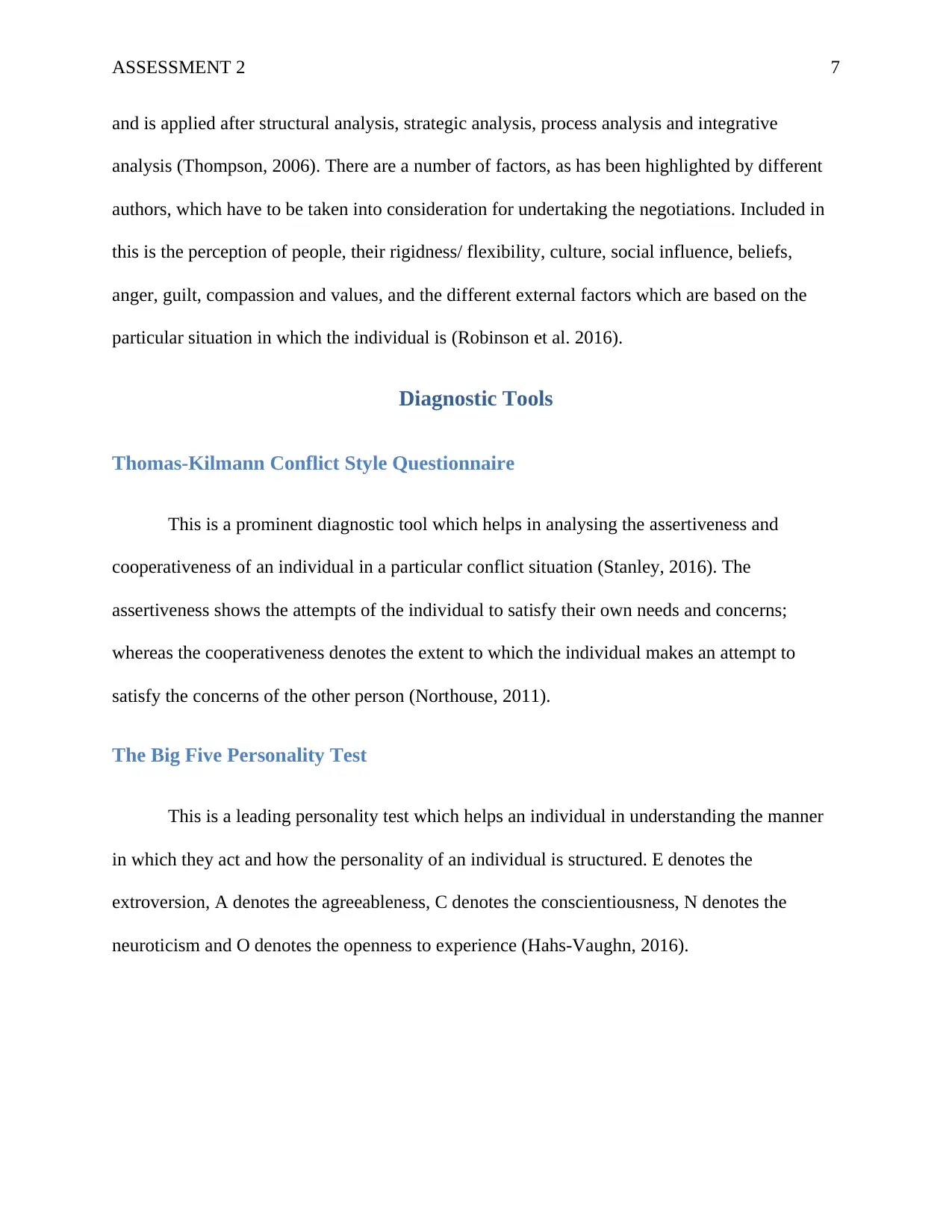
ASSESSMENT 2 7
and is applied after structural analysis, strategic analysis, process analysis and integrative
analysis (Thompson, 2006). There are a number of factors, as has been highlighted by different
authors, which have to be taken into consideration for undertaking the negotiations. Included in
this is the perception of people, their rigidness/ flexibility, culture, social influence, beliefs,
anger, guilt, compassion and values, and the different external factors which are based on the
particular situation in which the individual is (Robinson et al. 2016).
Diagnostic Tools
Thomas-Kilmann Conflict Style Questionnaire
This is a prominent diagnostic tool which helps in analysing the assertiveness and
cooperativeness of an individual in a particular conflict situation (Stanley, 2016). The
assertiveness shows the attempts of the individual to satisfy their own needs and concerns;
whereas the cooperativeness denotes the extent to which the individual makes an attempt to
satisfy the concerns of the other person (Northouse, 2011).
The Big Five Personality Test
This is a leading personality test which helps an individual in understanding the manner
in which they act and how the personality of an individual is structured. E denotes the
extroversion, A denotes the agreeableness, C denotes the conscientiousness, N denotes the
neuroticism and O denotes the openness to experience (Hahs-Vaughn, 2016).
and is applied after structural analysis, strategic analysis, process analysis and integrative
analysis (Thompson, 2006). There are a number of factors, as has been highlighted by different
authors, which have to be taken into consideration for undertaking the negotiations. Included in
this is the perception of people, their rigidness/ flexibility, culture, social influence, beliefs,
anger, guilt, compassion and values, and the different external factors which are based on the
particular situation in which the individual is (Robinson et al. 2016).
Diagnostic Tools
Thomas-Kilmann Conflict Style Questionnaire
This is a prominent diagnostic tool which helps in analysing the assertiveness and
cooperativeness of an individual in a particular conflict situation (Stanley, 2016). The
assertiveness shows the attempts of the individual to satisfy their own needs and concerns;
whereas the cooperativeness denotes the extent to which the individual makes an attempt to
satisfy the concerns of the other person (Northouse, 2011).
The Big Five Personality Test
This is a leading personality test which helps an individual in understanding the manner
in which they act and how the personality of an individual is structured. E denotes the
extroversion, A denotes the agreeableness, C denotes the conscientiousness, N denotes the
neuroticism and O denotes the openness to experience (Hahs-Vaughn, 2016).
Paraphrase This Document
Need a fresh take? Get an instant paraphrase of this document with our AI Paraphraser
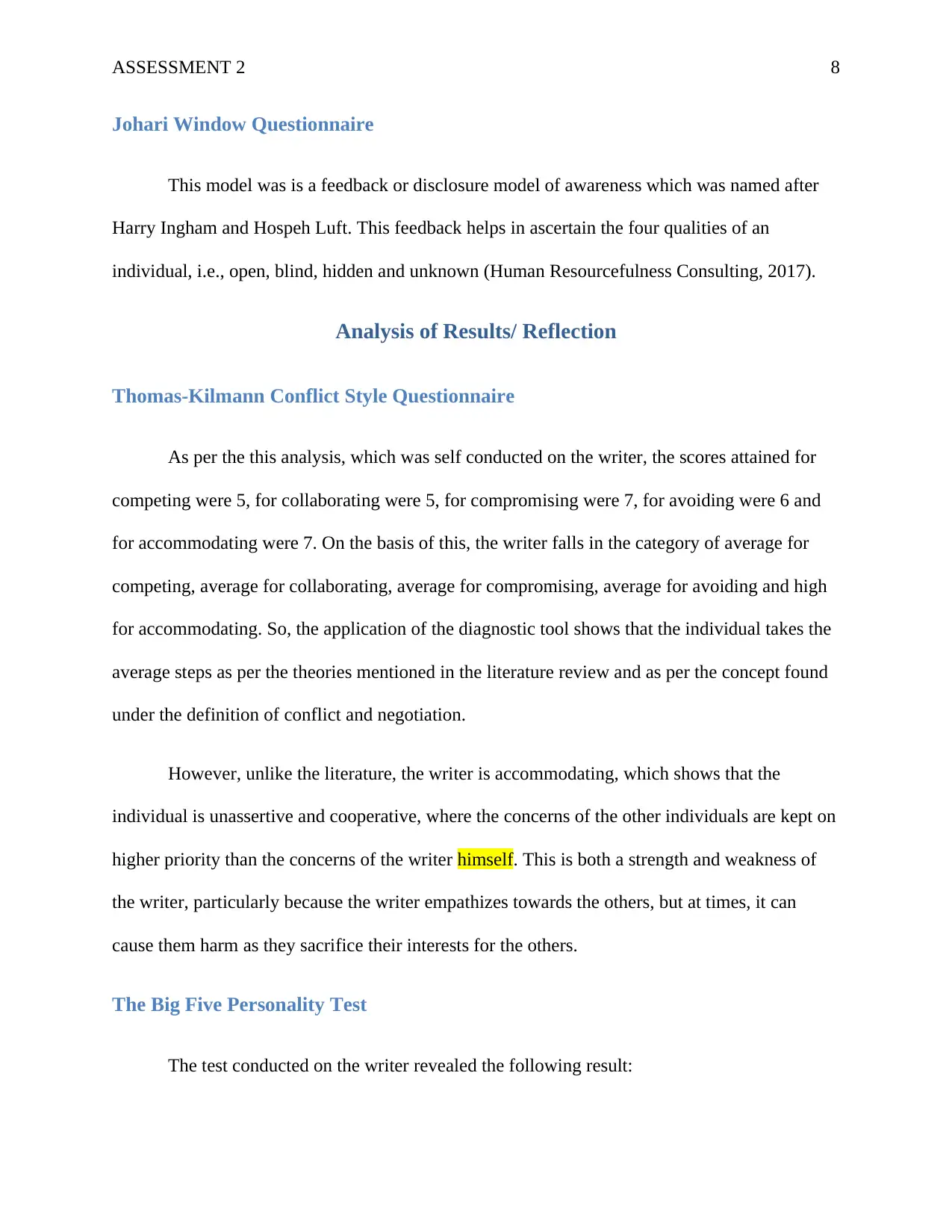
ASSESSMENT 2 8
Johari Window Questionnaire
This model was is a feedback or disclosure model of awareness which was named after
Harry Ingham and Hospeh Luft. This feedback helps in ascertain the four qualities of an
individual, i.e., open, blind, hidden and unknown (Human Resourcefulness Consulting, 2017).
Analysis of Results/ Reflection
Thomas-Kilmann Conflict Style Questionnaire
As per the this analysis, which was self conducted on the writer, the scores attained for
competing were 5, for collaborating were 5, for compromising were 7, for avoiding were 6 and
for accommodating were 7. On the basis of this, the writer falls in the category of average for
competing, average for collaborating, average for compromising, average for avoiding and high
for accommodating. So, the application of the diagnostic tool shows that the individual takes the
average steps as per the theories mentioned in the literature review and as per the concept found
under the definition of conflict and negotiation.
However, unlike the literature, the writer is accommodating, which shows that the
individual is unassertive and cooperative, where the concerns of the other individuals are kept on
higher priority than the concerns of the writer himself. This is both a strength and weakness of
the writer, particularly because the writer empathizes towards the others, but at times, it can
cause them harm as they sacrifice their interests for the others.
The Big Five Personality Test
The test conducted on the writer revealed the following result:
Johari Window Questionnaire
This model was is a feedback or disclosure model of awareness which was named after
Harry Ingham and Hospeh Luft. This feedback helps in ascertain the four qualities of an
individual, i.e., open, blind, hidden and unknown (Human Resourcefulness Consulting, 2017).
Analysis of Results/ Reflection
Thomas-Kilmann Conflict Style Questionnaire
As per the this analysis, which was self conducted on the writer, the scores attained for
competing were 5, for collaborating were 5, for compromising were 7, for avoiding were 6 and
for accommodating were 7. On the basis of this, the writer falls in the category of average for
competing, average for collaborating, average for compromising, average for avoiding and high
for accommodating. So, the application of the diagnostic tool shows that the individual takes the
average steps as per the theories mentioned in the literature review and as per the concept found
under the definition of conflict and negotiation.
However, unlike the literature, the writer is accommodating, which shows that the
individual is unassertive and cooperative, where the concerns of the other individuals are kept on
higher priority than the concerns of the writer himself. This is both a strength and weakness of
the writer, particularly because the writer empathizes towards the others, but at times, it can
cause them harm as they sacrifice their interests for the others.
The Big Five Personality Test
The test conducted on the writer revealed the following result:
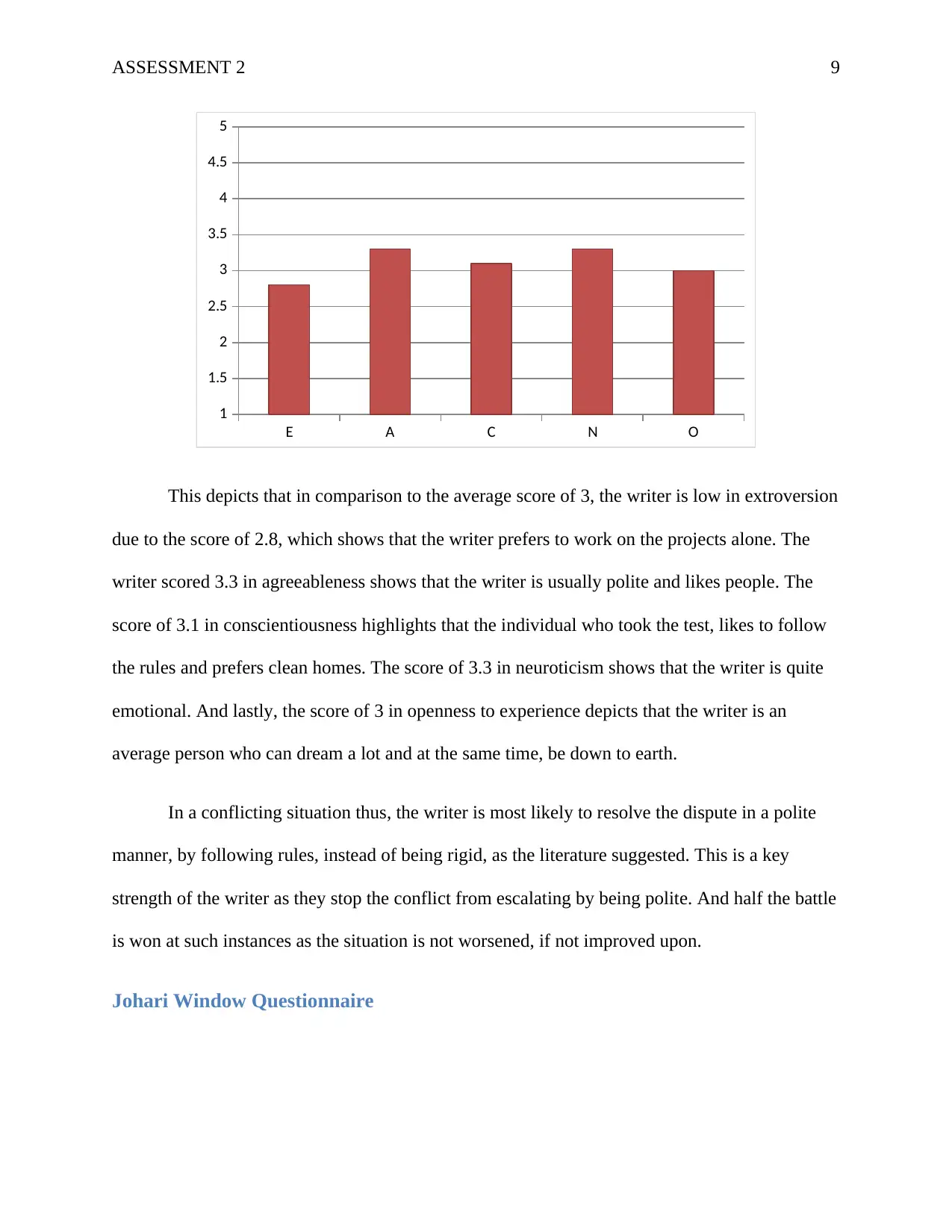
ASSESSMENT 2 9
E A C N O
1
1.5
2
2.5
3
3.5
4
4.5
5
This depicts that in comparison to the average score of 3, the writer is low in extroversion
due to the score of 2.8, which shows that the writer prefers to work on the projects alone. The
writer scored 3.3 in agreeableness shows that the writer is usually polite and likes people. The
score of 3.1 in conscientiousness highlights that the individual who took the test, likes to follow
the rules and prefers clean homes. The score of 3.3 in neuroticism shows that the writer is quite
emotional. And lastly, the score of 3 in openness to experience depicts that the writer is an
average person who can dream a lot and at the same time, be down to earth.
In a conflicting situation thus, the writer is most likely to resolve the dispute in a polite
manner, by following rules, instead of being rigid, as the literature suggested. This is a key
strength of the writer as they stop the conflict from escalating by being polite. And half the battle
is won at such instances as the situation is not worsened, if not improved upon.
Johari Window Questionnaire
E A C N O
1
1.5
2
2.5
3
3.5
4
4.5
5
This depicts that in comparison to the average score of 3, the writer is low in extroversion
due to the score of 2.8, which shows that the writer prefers to work on the projects alone. The
writer scored 3.3 in agreeableness shows that the writer is usually polite and likes people. The
score of 3.1 in conscientiousness highlights that the individual who took the test, likes to follow
the rules and prefers clean homes. The score of 3.3 in neuroticism shows that the writer is quite
emotional. And lastly, the score of 3 in openness to experience depicts that the writer is an
average person who can dream a lot and at the same time, be down to earth.
In a conflicting situation thus, the writer is most likely to resolve the dispute in a polite
manner, by following rules, instead of being rigid, as the literature suggested. This is a key
strength of the writer as they stop the conflict from escalating by being polite. And half the battle
is won at such instances as the situation is not worsened, if not improved upon.
Johari Window Questionnaire
⊘ This is a preview!⊘
Do you want full access?
Subscribe today to unlock all pages.

Trusted by 1+ million students worldwide
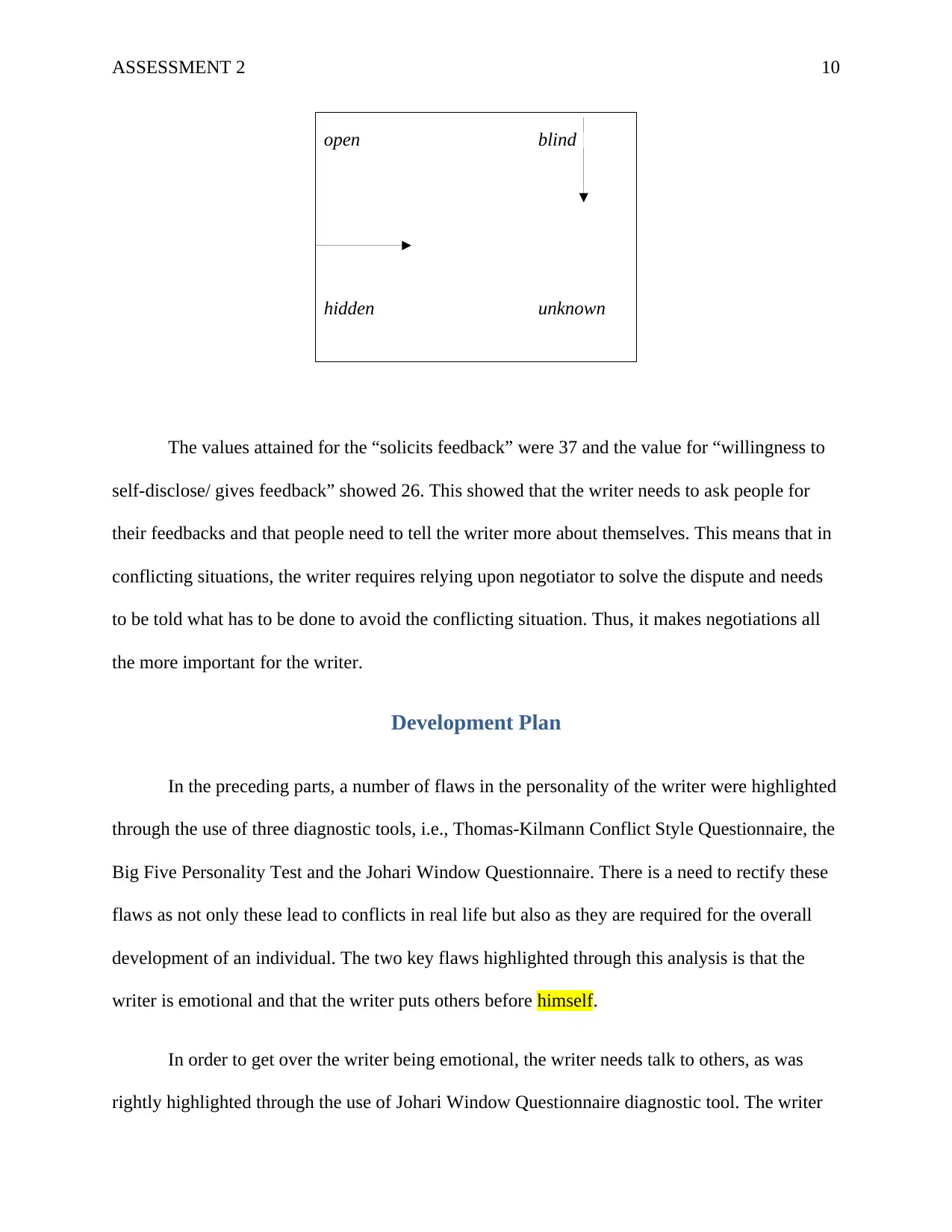
ASSESSMENT 2 10
open blind
hidden unknown
The values attained for the “solicits feedback” were 37 and the value for “willingness to
self-disclose/ gives feedback” showed 26. This showed that the writer needs to ask people for
their feedbacks and that people need to tell the writer more about themselves. This means that in
conflicting situations, the writer requires relying upon negotiator to solve the dispute and needs
to be told what has to be done to avoid the conflicting situation. Thus, it makes negotiations all
the more important for the writer.
Development Plan
In the preceding parts, a number of flaws in the personality of the writer were highlighted
through the use of three diagnostic tools, i.e., Thomas-Kilmann Conflict Style Questionnaire, the
Big Five Personality Test and the Johari Window Questionnaire. There is a need to rectify these
flaws as not only these lead to conflicts in real life but also as they are required for the overall
development of an individual. The two key flaws highlighted through this analysis is that the
writer is emotional and that the writer puts others before himself.
In order to get over the writer being emotional, the writer needs talk to others, as was
rightly highlighted through the use of Johari Window Questionnaire diagnostic tool. The writer
open blind
hidden unknown
The values attained for the “solicits feedback” were 37 and the value for “willingness to
self-disclose/ gives feedback” showed 26. This showed that the writer needs to ask people for
their feedbacks and that people need to tell the writer more about themselves. This means that in
conflicting situations, the writer requires relying upon negotiator to solve the dispute and needs
to be told what has to be done to avoid the conflicting situation. Thus, it makes negotiations all
the more important for the writer.
Development Plan
In the preceding parts, a number of flaws in the personality of the writer were highlighted
through the use of three diagnostic tools, i.e., Thomas-Kilmann Conflict Style Questionnaire, the
Big Five Personality Test and the Johari Window Questionnaire. There is a need to rectify these
flaws as not only these lead to conflicts in real life but also as they are required for the overall
development of an individual. The two key flaws highlighted through this analysis is that the
writer is emotional and that the writer puts others before himself.
In order to get over the writer being emotional, the writer needs talk to others, as was
rightly highlighted through the use of Johari Window Questionnaire diagnostic tool. The writer
Paraphrase This Document
Need a fresh take? Get an instant paraphrase of this document with our AI Paraphraser
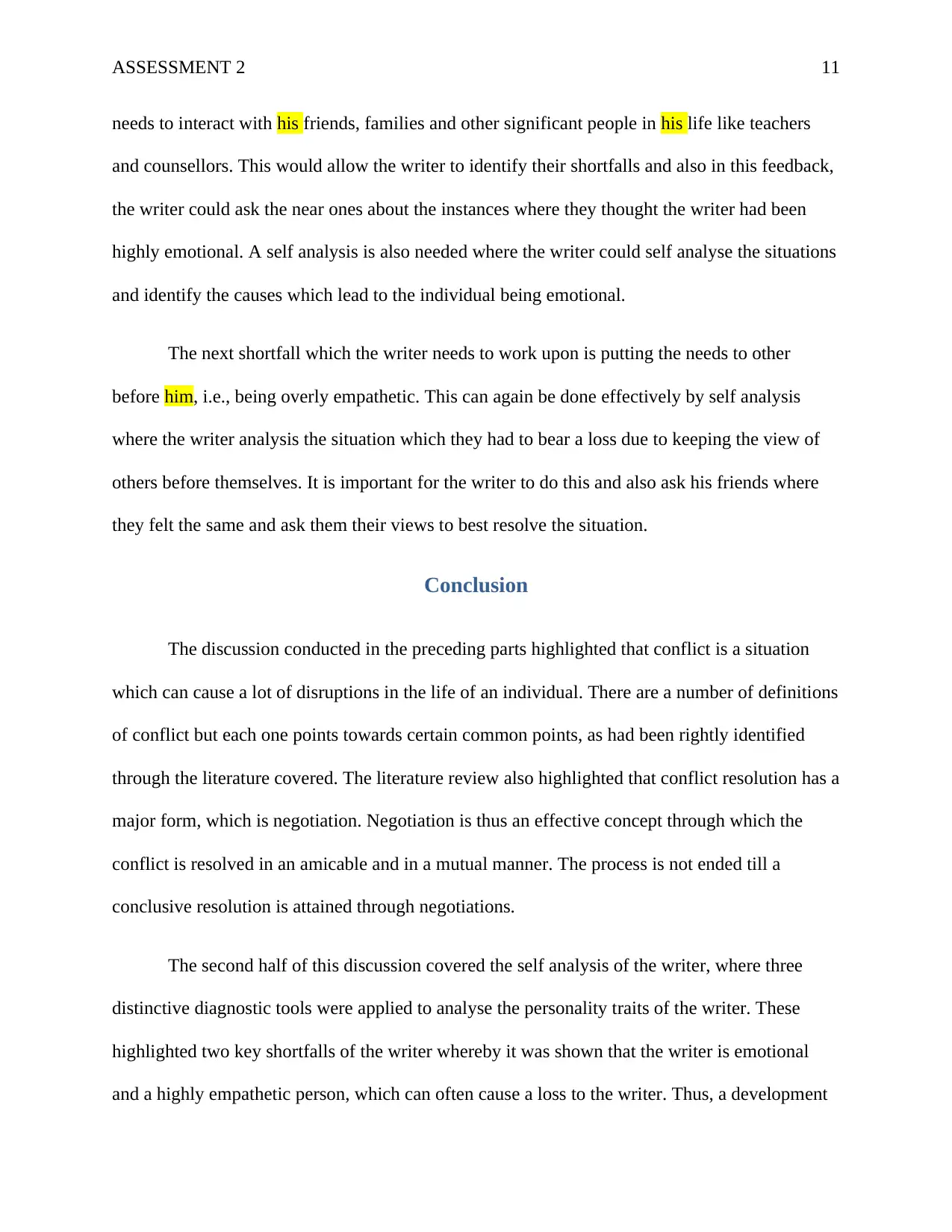
ASSESSMENT 2 11
needs to interact with his friends, families and other significant people in his life like teachers
and counsellors. This would allow the writer to identify their shortfalls and also in this feedback,
the writer could ask the near ones about the instances where they thought the writer had been
highly emotional. A self analysis is also needed where the writer could self analyse the situations
and identify the causes which lead to the individual being emotional.
The next shortfall which the writer needs to work upon is putting the needs to other
before him, i.e., being overly empathetic. This can again be done effectively by self analysis
where the writer analysis the situation which they had to bear a loss due to keeping the view of
others before themselves. It is important for the writer to do this and also ask his friends where
they felt the same and ask them their views to best resolve the situation.
Conclusion
The discussion conducted in the preceding parts highlighted that conflict is a situation
which can cause a lot of disruptions in the life of an individual. There are a number of definitions
of conflict but each one points towards certain common points, as had been rightly identified
through the literature covered. The literature review also highlighted that conflict resolution has a
major form, which is negotiation. Negotiation is thus an effective concept through which the
conflict is resolved in an amicable and in a mutual manner. The process is not ended till a
conclusive resolution is attained through negotiations.
The second half of this discussion covered the self analysis of the writer, where three
distinctive diagnostic tools were applied to analyse the personality traits of the writer. These
highlighted two key shortfalls of the writer whereby it was shown that the writer is emotional
and a highly empathetic person, which can often cause a loss to the writer. Thus, a development
needs to interact with his friends, families and other significant people in his life like teachers
and counsellors. This would allow the writer to identify their shortfalls and also in this feedback,
the writer could ask the near ones about the instances where they thought the writer had been
highly emotional. A self analysis is also needed where the writer could self analyse the situations
and identify the causes which lead to the individual being emotional.
The next shortfall which the writer needs to work upon is putting the needs to other
before him, i.e., being overly empathetic. This can again be done effectively by self analysis
where the writer analysis the situation which they had to bear a loss due to keeping the view of
others before themselves. It is important for the writer to do this and also ask his friends where
they felt the same and ask them their views to best resolve the situation.
Conclusion
The discussion conducted in the preceding parts highlighted that conflict is a situation
which can cause a lot of disruptions in the life of an individual. There are a number of definitions
of conflict but each one points towards certain common points, as had been rightly identified
through the literature covered. The literature review also highlighted that conflict resolution has a
major form, which is negotiation. Negotiation is thus an effective concept through which the
conflict is resolved in an amicable and in a mutual manner. The process is not ended till a
conclusive resolution is attained through negotiations.
The second half of this discussion covered the self analysis of the writer, where three
distinctive diagnostic tools were applied to analyse the personality traits of the writer. These
highlighted two key shortfalls of the writer whereby it was shown that the writer is emotional
and a highly empathetic person, which can often cause a loss to the writer. Thus, a development
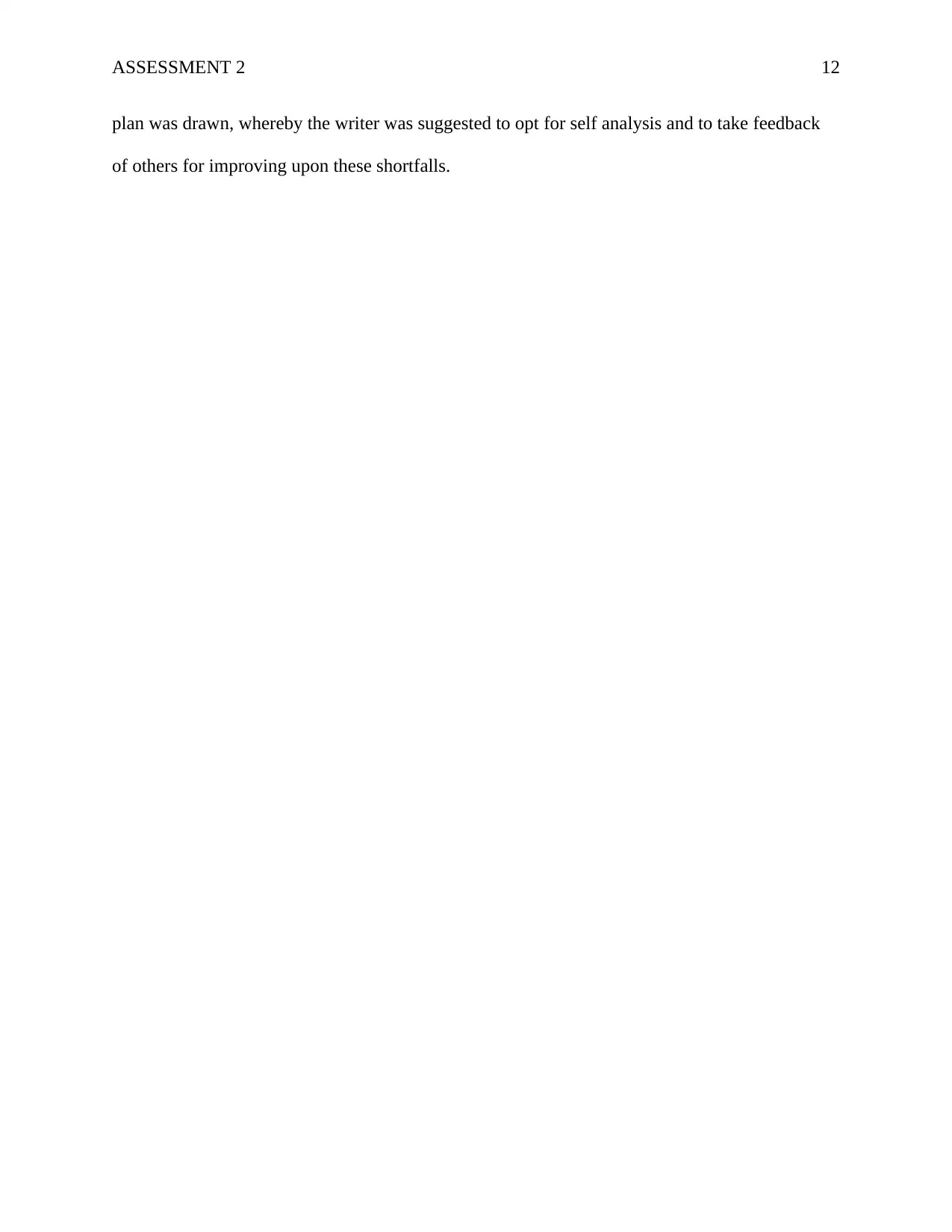
ASSESSMENT 2 12
plan was drawn, whereby the writer was suggested to opt for self analysis and to take feedback
of others for improving upon these shortfalls.
plan was drawn, whereby the writer was suggested to opt for self analysis and to take feedback
of others for improving upon these shortfalls.
⊘ This is a preview!⊘
Do you want full access?
Subscribe today to unlock all pages.

Trusted by 1+ million students worldwide
1 out of 26
Your All-in-One AI-Powered Toolkit for Academic Success.
+13062052269
info@desklib.com
Available 24*7 on WhatsApp / Email
![[object Object]](/_next/static/media/star-bottom.7253800d.svg)
Unlock your academic potential
Copyright © 2020–2025 A2Z Services. All Rights Reserved. Developed and managed by ZUCOL.